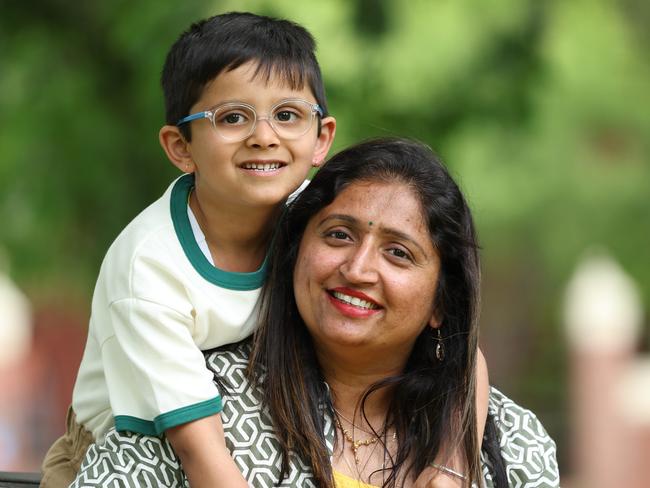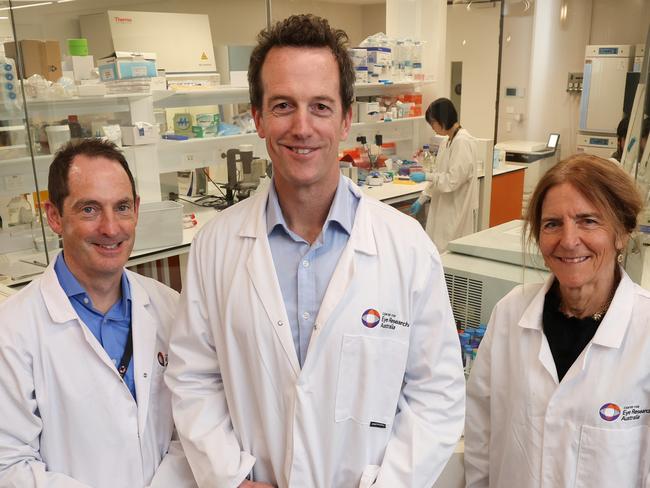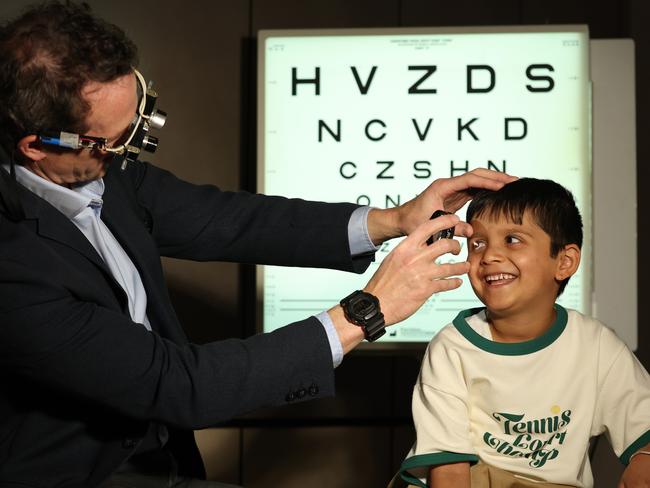The revolution in healthcare that comes from the genes
From saving a child’s sight to determining the risks of passing cancer genes from one generation to another, genetic testing is moving healthcare into a new era.
News
Don't miss out on the headlines from News. Followed categories will be added to My News.
It was a mother’s instinct and fierce determination that helped to save the sight of Melbourne schoolboy Krisshiv.
The family, who asked that their surname not be used, searched the world for a treatment to prevent their only child going blind from a rare inherited retinal disease (IRD).
IRDs are a broad group of genetic eye conditions that cause vision loss and blindness and are the leading cause of blindness in adult Australians.
In the end, the family found a cure for Krisshiv closer to home.
Mum Bhav first noticed something was wrong when her son was just two months old.
“I felt a lack of that crucial eye contact between mother and baby,” she said. “We had waited so long for him, especially after three miscarriages, so he was incredibly precious to us.”
Bhav and her husband Alppesh took their son to the Royal Children’s Hospital. “That’s where our journey began,” she said.
Despite MRIs and various tests, doctors couldn’t determine the cause of Krisshiv’s vision loss, and the family was devastated by the thought that their long-awaited child might lose his sight during childhood.

“We were worried for his future,” Bhav said. “We were willing to go wherever we needed to do what we had to.”
From six months of age Krisshiv started having regular check-ups and at one appointment a doctor at the RCH told the family about a new gene therapy treatment.
“We went through genetic testing, but initially there was nothing significant that could affect his vision,” Bhav said.
“We then went to India where there is one of the biggest hospitals in the world for inherited retinal diseases. There I saw a doctor, he also pointed out this particular therapy, but wasn’t sure if it was available in Australia.”
To be treated, Krisshiv’s condition also had to be caused by a particular rare rogue gene.
Finally their stars aligned.
Genetic testing confirmed Krisshiv had the gene and the budding mathematician, pilot and astronaut became the first child in Victoria to be treated with the new therapy called Luxturna.
“It saved his sight,” Bhav said. “Within a week he started making eye contact in low light and at night, and we noticed significant improvements in his vision after the gene therapy. It was like winning the jackpot. His vision is everything.”
She said the family was forever grateful for the expertise and care of the team who saved Krisshiv’s sight. “It is a miracle.”

Miracle of modern medicine
Pioneer scientist Jean Bennett discovered the gene therapy that has saved the sight of hundreds of people worldwide, including Krisshiv.
It is a one-off therapy that helps improve functional vision in patients with an IRD due to a specific gene mutation and works by delivering a new copy of that gene into the eye.
Her discovery is a modern medicine miracle and in the hands of specialist retinal surgeons, is saving sight.
It is also life-changing as this particular IRD causes visual impairments and blindness early in life.
Prof Bennett was in Melbourne in November to deliver the annual Crock Lecture at the invitation of the Centre for Eye Research Australia (CERA).
The event was a sell out, so tantalising and respected is her research and vision for gene therapy to treat blindness.
The Professor of Ophthalmology in the Perelman School of Medicine at the University of Pennsylvania discovered how to replace a missing protein due to a specific gene mutation.
“That protein is critical for allowing the retina to be able to see,” Prof Bennett said. “It allows the photoreceptors, the cells in the retina that begin the whole visual process, to be able to respond to light.
“Without this particular protein, the cells can’t see light so it’s kind of a simple scenario, or what we thought would be a simple scenario, for gene replacement where you’re missing this functional gene and you put it back in and correct the circuit and it works.”
Luxturna is delivered under sedation as a one-off injection by surgeons such Dr Tom Edwards, who treated Krisshiv.
From bench to bedside
Dr Edwards wears two professional hats: the clinician-scientist does research through CERA where he co-leads its Retinal Gene Therapy program with colleague Professor Lauren Ayton.
He is also a vitreoretinal surgeon at The Royal Victorian Eye and Ear Hospital, which is the designated Victorian hospital provider for Luxturna for eligible patients.
Vitreoretinal is a specialised type of surgery focused on the retina and also on the vitreous part of the eye, the clear gel that fills the eye between the lens and retina.
Collaboration in science allows discoveries at the bench to move to the bedside to deliver life-changing cures for patients. To do so it has to be agile and think outside the box.
That’s what Prof Bennett and her team did.
“We first showed that it works in puppies born blind due to spontaneous mutation in the Briard breed of dog,” she said.
“These puppies were so fearful. They’d hide in their corners because if somebody touched them, they couldn’t see a hand coming toward them and they couldn’t find their water bowl, and afterwards they could catch balls and play with each other and they were happy, their tails wagging.”
While Prof Bennett’s research to use gene therapy to reverse IRD started in the 1980s, the puppies gave the team its longed-for Eureka moment.
“If we could make blind puppies see, could we make blind children see?”
The answer was yes, but it would take another 17 years to bring it to market.
The first child was treated in 2008, a Belgian boy who was 10, and the second an American boy aged eight.
“They are all grown up now. They have finished their schooling, they’re working, living independently and they are still seeing,” she said.
The therapy has now been taken up worldwide, including in Australia.
“This is a rare disease,” Prof Bennett said. “The children must have genetic testing first, that’s a prerequisite to the treatment because if somebody was blind due to a different genetic defect it wouldn’t work.”
She is now working on potential gene therapy treatments for more than a dozen different forms of blindness.
View from Victoria

Here in Victoria, the CERA team is also researching the use of gene therapy to prevent people from going blind.
CERA is an independent medical research institute affiliated with the University of Melbourne through the Department of Surgery (Ophthalmology) and has a research relationship with The Royal Victorian Eye and Ear Hospital.
Its focus is on preventing vision loss and blindness and the team’s clinical researchers work closely with the Ocular Genetics Clinic at the hospital.
Lauren Ayton has a particular interest in how to prove that these treatments improve life for people with inherited risk of vision loss.
“I co-lead the team with Tom Edwards, who is a surgeon, so he does the treatment and our team runs the trials and does the research into these conditions,” she said.
CERA’s managing director Professor Keith Martin has also founded two commercial companies to develop gene therapy for glaucoma and macular degeneration, the leading cause of severe vision loss in Australia affecting around 1.7 million Australians.
Prof Ayton said only a decade ago genetic testing for eye disease was not done.
“Basically if someone had one of these conditions all we would say was that the cause was genetic, but there’s nothing we can do,” she said.
“Whereas now there are gene-specific treatments that are commercially available, such as the one Jean’s team developed, which is fantastic.”

Giving hope
A paper recently published by the CERA team in the journal Clinical and Experimental Ophthalmology highlights how genetic testing is changing the course of eye disease.
Professor Ayton was the senior author with Parker Truong through the Victorian evolution of inherited retinal diseases natural history registry, known as the VENTURE study.
This study is a collaboration between CERA and the University of Melbourne and collects data from people with IRDs for research and to keep patients informed of upcoming trials and treatment opportunities.
In the paper the authors described the case of a Melbourne mum who finally received the correct diagnosis for her vision loss after 40 years.
“Advances in genomic research means more people can find out what is causing their vision loss, and rapid advances in research provides hope for new treatments to stall vision loss and restore sight,” Professor Ayton said.
“Being part of a study that provides genetic testing helps to identify people who might be suitable for clinical trials of new, emerging treatments.
“The value of genetic testing for patients with rare diseases cannot be overstated.”
Her goal remains curing all IRDs and stopping blindness “full stop”, but Prof Ayton said the secondary goal was getting people the health care they need to manage their vision and life more easily.
Family ties
The conversation started with an apology. One of the country’s leading oncologists faced his two daughters to say sorry that he hadn’t thought to have a blood test much sooner.
Not for prostate cancer. He had shared that news with them a few years earlier, had been successfully treated and was now on the road to recovery.
This time Professor Grant McArthur, chief executive of the Victorian Comprehensive Cancer Centre Alliance, was talking about a genetic test to see if he carried genetic risk mutations including the BRCA1 or BRCA2 gene mutations.
“I apologised to my daughters for not thinking of them and getting genetic testing done sooner,” Prof McArthur said.
The “eye opener” came, he said, when he was having a scientific conversation with famed British medical geneticist Gareth Evans.
“We were chatting and I said, I’ve had prostate cancer and he asked me if I’d had genetic testing,” Prof McArthur said.
“Suddenly the penny dropped as to why he asked me that. It was because of the risk to my daughters, Sarah and Chloe.”

Genetic testing would confirm if his prostate cancer had been triggered by a mutation of the BRCA gene and put his daughters at greater risk of breast cancer.
The BRCA acronym stands for BReast CAncer and while men can get breast cancer, it is rare.
Prof McArthur certainly considered the impact of his cancer diagnosis on his only son Ethan, now 27. But in that moment he knew the biggest risk was to his daughters: young women about to embark on their own medical careers.
“If you do carry one of these genes it’s much earlier onset in life of breast or ovarian cancer, as opposed to my son whose risk doesn’t really start until he’s getting up around 50 years of age,” he said.
He is now on a mission to make men with a prostate cancer diagnosis and the people treating them more aware of the role genetics can play.
Prof McArthur says genetic testing is moving health care into a new era, one where eventually adults will routinely get genetic profiles showing risks of all sorts of things which would then be managed earlier to maximise their chances of good health.
For now he wants greater awareness for patients, for oncologists and for urologists about men with prostate cancer to think about cancer risk in their daughters.
“That’s the thing with cancer, if we get cancers early, or we’re aware of risk, we can do something about it.”

Prof McArthur was lucky. His genetic test confirmed he did not carry the rogue gene and his girls were in the clear.
“Fortunately, I didn’t have these inherited germ line-risk genetic changes that would predispose my daughters to breast or ovarian cancer and other cancers,” Prof McArthur said.
Germ line mutations, also called hereditary mutations, are passed on from parents to offspring. Inherited germ line mutations play an important role in cancer risk and susceptibility.
Men who have a BRCA1 or BRCA2 gene mutation have a higher risk of developing certain cancers, including prostate, pancreatic and breast cancer.
It is now a decade since Prof McArthur: scientist, physician, globally respected melanoma expert; husband to Maree and dad received his shock prostate cancer diagnosis.
“I’m all clear, which is excellent” he said. “I’m feeling very pleased that, thanks to my GP back in 2014, I got detected in time.”
While he felt immense sorrow at not having a genetic test sooner for the sake of his daughters, they remember that conversation differently, with both describing it almost with a sense of relief.

Sarah, 30, and an oncology registrar, and Chloe, 23, studying to become a nuclear medicine technologist, say the last time they had such a serious sit down with their dad it was to hear he had cancer.
“I was 13 when dad was diagnosed with prostate cancer,” Chloe said. “I don’t think I really knew what the BRCA gene was then and I was mainly concerned for dad, but the thought went through my head about my brother.
“When I did science at school and in university and I was learning about the BRCA gene the thought crossed my mind, but I never really thought to even really discuss it much. It wasn’t until dad mentioned it to me.”
Chloe said they were reassured when their father’s test came back clear. “If it hadn’t, I’d obviously consider all my options and then discuss it with genetic counsellors.”
Sarah, who was married in March to Adam Lipszyc, said hearing that her father had cancer came as a big shock.
“I just heard the word cancer and not much else,” she said. “Later in my training I heard about the link between BRCA and prostate cancer and the thought vaguely crossed my mind because dad was diagnosed pretty young.
“I just put it out of my mind because I thought I’m sure he would have said something, being who he is.”
She said there was a lot more talk now about genetic testing on the wards and about referring people to the familial cancer clinics.
“I think the awareness is growing.”
Sarah McArthur will soon qualify herself as an oncologist, just like her father. “I just fell in love with it and I guess you can’t fight your genetics.”
What is genetic testing?
A blood or saliva test that identifies changes earlier in genes that can cause health problems
Families at risk may be referred to genetic counselling to understand the results and impact
The test can be done privately, but can be expensive. There can be a wait of up two years if you go public
The first step should always be to discuss any concerns with your GP, who will help decide if a referral to a familial clinic is needed
GPs will look at family history, changes in your health or if a close relative has a type of cancer that could be inherited
Couples planning a family can be tested for a genetic condition that could be passed on to children
If cancer seems to run in your family and you want to understand your hereditary risk, talk first to your GP who may refer you to a familial cancer centre which provides genetic testing, support and expert advice about prevention options.
The Peter MacCallum Cancer Centre has an online tool called iPrevent that can also help women to understand their risk of breast cancer, including hereditary risk.
The tool generates a personalised report which women are encouraged to talk about with their GP.
It takes about 30 minutes. Visit: www.petermac.org/iprevent
What is Inherited Retinal Disease?
The term describes a broad group of genetic eye conditions that cause vision loss and blindness
They are the leading cause of blindness in adult Australians
Joining in a clinical trial is one way to access genetic testing for free. For details visit: www.cera.org.au
Prostate cancer
The Prostate Cancer Foundation of Australia says around 10 per cent of all prostate cancer cases are caused by an inherited genetic risk
Up to 12 per cent of men with metastatic castration-resistant prostate cancer carry inherited BRCA1/2 mutations
More Coverage
Originally published as The revolution in healthcare that comes from the genes




